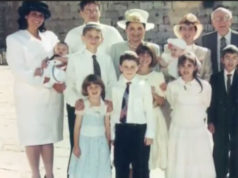 The fourth of Iyar, the day before Israel’s Independence Day, was declared by the Israeli Knesset to be a Memorial Day for those who lost their lives in the struggle that led to the establishment of the State of Israel and for all military personnel who were killed while in active duty in Israel’s armed forces. Joining these two days together conveys a simple message: Israelis owe the independence and the very existence of the Jewish state to the soldiers who sacrificed their lives for it.
The fourth of Iyar, the day before Israel’s Independence Day, was declared by the Israeli Knesset to be a Memorial Day for those who lost their lives in the struggle that led to the establishment of the State of Israel and for all military personnel who were killed while in active duty in Israel’s armed forces. Joining these two days together conveys a simple message: Israelis owe the independence and the very existence of the Jewish state to the soldiers who sacrificed their lives for it.
Yom Hazikaron, Israel’s Memorial Day, is different in its character and mood from America’s Memorial Day. For 24 hours—from sunset to sunset—all places of public entertainment—theaters, cinemas, nightclubs and pubs—are closed. The most noticeable feature of the day is the sound of a siren that is heard throughout the country twice, during which the entire nation observes a two-minutes “standstill” of all traffic and daily activities. The first siren marks the beginning of Memorial Day at 8 pm, and the second is at 11 am, before the public recitation of prayers in the military cemeteries. All radio and television stations broadcast programs portraying the lives and heroic deeds of fallen soldiers. Most of the broadcasting time is devoted to Israeli songs that convey the mood of the day.
Magash Hakesef (The Silver Platter), a poem written by Nathan Alterman during the 1948 War of Independence, was during the 1950s and ‘60s the most common reading for Yom Hazikaron ceremonies. The poem attained a status almost similar to Lincoln’s Gettysburg Address.
During the ‘70s, especially following the Six-Day War and the Yom Kippur War, numerous new poems and songs commemorating fallen soldiers became popular and often replaced The Silver Platter in public ceremonies. Hare’ut (Friendship), a song composed a year after the 1948 war, had an impressive comeback in the 1980s and ‘90s. This poem/song was late Prime Minister Yithak Rabin’s favorite.
Almost every high school in Israel has a memorial corner with photos of the school graduates who fell in battle or while on military duty. Some high schools organize their own Yom Hazikaron ceremonies and invite the families of the fallen graduates to participate. The unique atmosphere of the day is enhanced by the sight of teenagers and children, all dressed in white shirts and blue pants or skirts, on their way to school, and thousands of soldiers in uniform on their way to military cemeteries.
The list of fallen soldiers becomes longer every year. The inevitable tendency of radio and television programs is to focus on individual stories of soldiers who lost their lives in recent decades rather than on those who fought in the pre-state undergrounds and 1948 war, who have fewer surviving relatives today.
Yom Hazikaron is not thought of as a religious commemoration by the majority of Israelis, but as part of the civil culture. The siren sound seems to inspire awe on a level with other traditional religious ceremonies.



